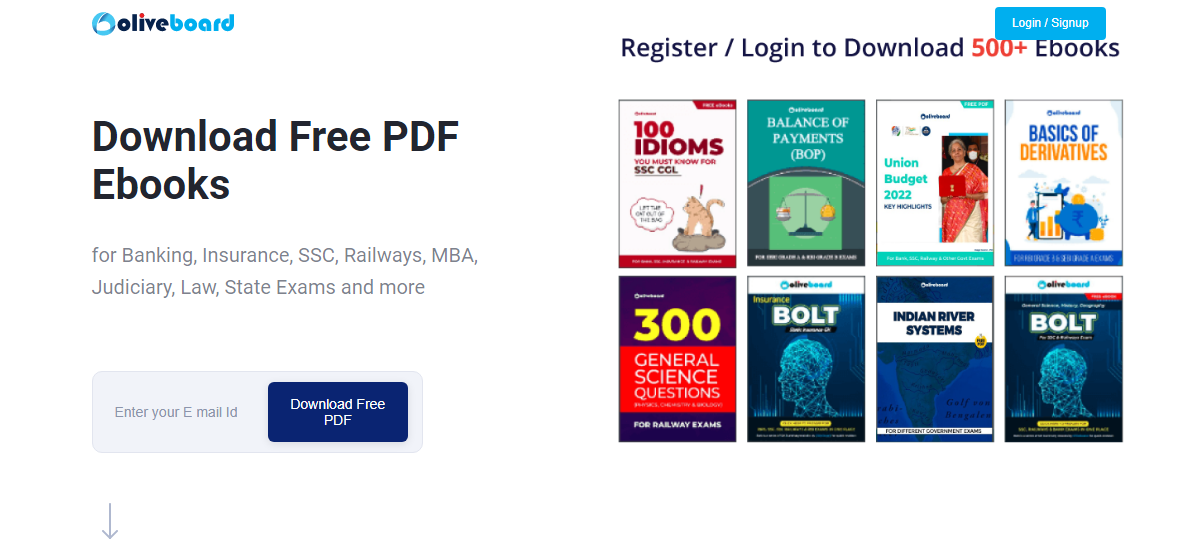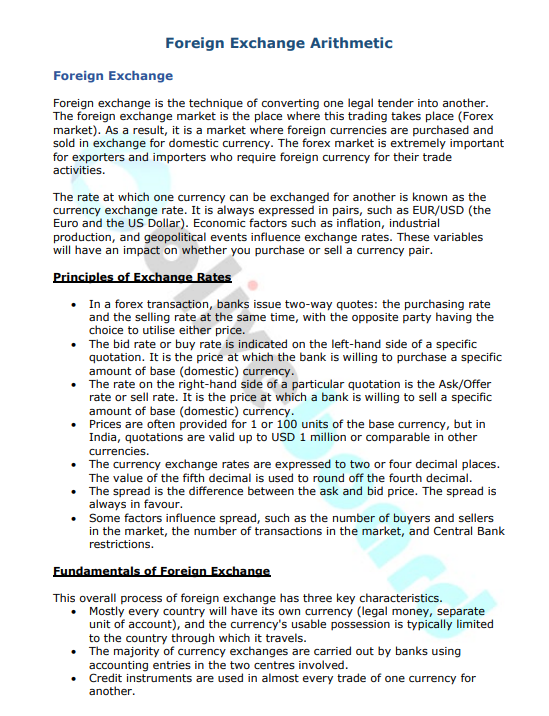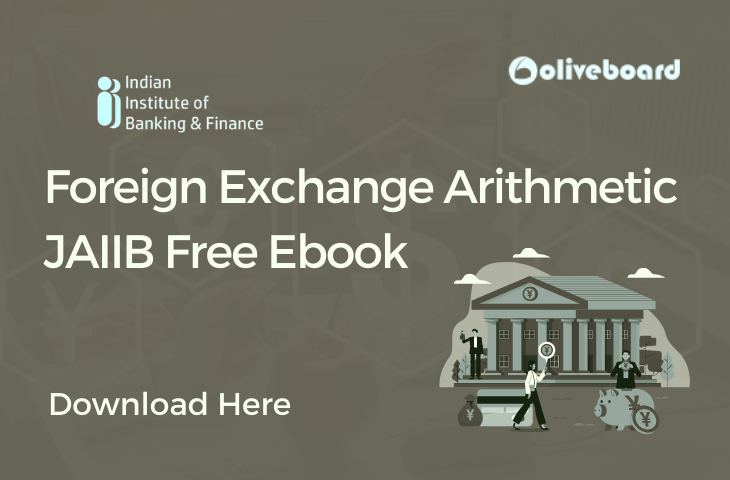Foreign exchange is the technique of converting one legal tender into another. The foreign exchange market is the place where this trading takes place (Forex market). As a result, it is a market where foreign currencies are purchased and sold in exchange for domestic currency. As Foreign Exchange Arithmetic is an vital topic for JAIIB Exam, We will discuss about Foreign Exchange Arithmetic in this Blog.
Download Foreign Exchange Arithmetic Ebook
How to Download Foreign Exchange Arithmetic E-book for JAIIB?
Step 1: Click on the download link. You will be redirected to Oliveboard’s FREE E-Books Page.

Step 2: Create a free Oliveboard account or login using your existing Oliveboard account details
Step 3: Download the book by clicking on the link presented on the page.
Introduction – Foreign Exchange
Foreign exchange is the technique of converting one legal tender into another. The foreign exchange market is the place where this trading takes place (Forex market). As a result, it is a market where foreign currencies are purchased and sold in exchange for domestic currency. The forex market is extremely important for exporters and importers who require foreign currency for their trade activities.
Principles of Exchange Rates
- In a forex transaction, banks issue two-way quotes: the purchasing rate and the selling rate at the same time, with the opposite party having the choice to utilise either price.
- The bid rate or buy rate is indicated on the left-hand side of a specific quotation. It is the price at which the bank is willing to purchase a specific amount of base (domestic) currency.
- The rate on the right-hand side of a particular quotation is the Ask/Offer rate or sell rate. It is the price at which a bank is willing to sell a specific amount of base (domestic) currency.
- Prices are often provided for 1 or 100 units of the base currency, but in India, quotations are valid up to USD 1 million or comparable in other currencies.
- The currency exchange rates are expressed to two or four decimal places. The value of the fifth decimal is used to round off the fourth decimal.
- The spread is the difference between the ask and bid price. The spread is always in favour.
- Some factors influence spread, such as the number of buyers and sellers in the market, the number of transactions in the market, and Central Bank restrictions.
Fundamentals of Foreign Exchange
This overall process of foreign exchange has three key characteristics.
- Mostly every country will have its own currency (legal money, separate unit of account), and the currency’s usable possession is typically limited to the country through which it travels.
- The majority of currency exchanges are carried out by banks using accounting entries in the two centres involved.
- Credit instruments are used in almost every trade of one currency for another.
Indian Forex Market
- In the short run, the currency rate changes in the Indian forex market may not always follow the international trend.
- The fundamental reason for this is that the free movement of capital into and out of the country is restricted.
- Before the ‘Liberalised Exchange Rate Management System’ (LERMS), the RBI controlled the buying and selling rate, and the market would stay within the Reserve Bank’s ceiling and floor.
- The Exchange rate is currently determined by the dynamics of supply and demand in the local Interbank market.
Direct and Indirect Quote
- When the value of one unit of foreign currency is given in terms of the domestic currency, the quote is direct.
- When the value of one unit of domestic currency is given in terms of foreign currency, the quote is indirect.
- Because the US dollar (USD) is the most widely used currency, exchange rates are normally expressed in USD. Cross currency exchange rates, on the other hand, are quoted against the currencies of other countries.
- In a straight quote, a lower exchange rate now indicates that the home currency is increasing in value. A lower exchange rate in an indirect quote, on the other hand, shows that the domestic currency is losing value since it is a worthless foreign currency.
Take a Sneak Peek at the Foreign Exchange Arithmetic E-book

Conclusion
This was all about Foreign Exchange Arithmetic for JAIIB. Our goal is to provide candidates with information that will help them prepare for the JAIIB exam. Keep following Oliveboard for more updates. To stay updated, follow Oliveboard on Facebook and Telegram.
FAQS
A. The trade of one currency for another is known as foreign exchange. For example, the US dollar can be exchanged for Indian rupees. The foreign exchange market, often known as the Forex Market, is where foreign exchange transactions may be made.
A. When the value of one unit of foreign currency is given in terms of the domestic currency, the quote is direct. But when the value of one unit of domestic currency is given in terms of foreign currency, the quote is indirect.
JAIIB Study Material Compilation
Also Read:
- Preparation Tips for JAIIB Exam- Last Minute Strategy
- JAIIB Revision Plan- Last 10 Days Plan
- JAIIB Frequently Asked Questions- 2022| Check Here (oliveboard.in)
- JAIIB Genius | JAIIB Weekly Quiz PDF – JAIIB Questions PDF (oliveboard.in)
- JAIIB Full Form – Junior Associate of the Indian Institute of Bankers (oliveboard.in)
- JAIIB and CAIIB Books- Exams Syllabus, Books, and more (oliveboard.in)
Also Check:
- JAIIB 2022 Exam -Notification Released (oliveboard.in)
- JAIIB Notification 2022 – Notification PDF, Eligibility, (oliveboard.in)
- JAIIB Apply Online – Application Form 2022, Fees, Instru (oliveboard.in)
- JAIIB Eligibility – Age, Degree, Nationality, Members (oliveboard.in)
- JAIIB Syllabus – Complete List of Papers, Modules (oliveboard.in)
- JAIIB Exam Pattern 2022 – Details of Pattern, Marking (oliveboard.in)
- JAIIB Admit Card November 2022 – Steps and Direct Download (oliveboard.in)
- JAIIB 2022 Cut Offs – Check JAIIB Minimum Cut Off (oliveboard.in)

Hello there! I’m a dedicated Government Job aspirant turned passionate writer & content marketer. My blogs are a one-stop destination for accurate and comprehensive information on exams like Regulatory Bodies, Banking, SSC, State PSCs, and more. I’m on a mission to provide you with all the details you need, conveniently in one place. When I’m not writing and marketing, you’ll find me happily experimenting in the kitchen, cooking up delightful treats. Join me on this journey of knowledge and flavors!
